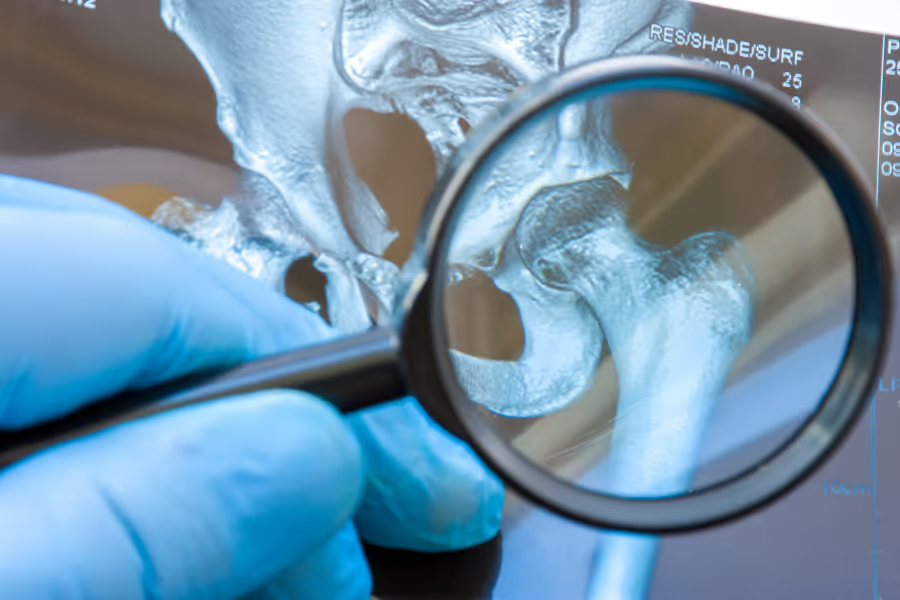Whether you need a partial or total hip replacement, find the right surgeon that fits your needs below, serving Canadians in major cities like Vancouver, British Columbia; Calgary, Alberta; Toronto, Ontario; and Montréal, Québec.
Informational purposes only, not medical or legal advice. Please consult your doctor or surgeon.

Hip replacement surgery (total hip arthroplasty) swaps out a worn‑out hip joint for smooth artificial parts so it moves without pain.
Think of your hip like a ball-and-socket hinge. When the cartilage wears out (arthritis), the bones grind and hurt. Surgery replaces:
Check out this article for a comprehensive overview on the different types of Hip Replacement surgery (i.e. anterior, posterior, lateral, robotic, etc).
The number one reason people consider private hip replacement is time. Hip replacements have some of the longest wait times in Canada—some will wait 2+ years. Given the median age for hip replacements is 65 in Canada, this amount of time is significant.
Instead of waiting months or years for surgery, private clinics often offer surgery within weeks. For many, this means less pain and a quicker return to daily life.
Going private generally gives you a sense of control, which can be reassuring during a difficult time. When you go private, you can:
Waiting in pain takes an emotional toll. With private care, patients often appreciate the clarity of knowing who will perform their surgery, when it’ll happen, and what the upfront costs will be. This certainty can ease anxiety and help families plan for recovery.

The surgery itself is no different from what’s performed in the public system. Surgeons use the same techniques, implants, and safety standards. The operation usually takes 2-3 hours.

The clinic will provide you with an extensive hip replacement surgery recovery plan that includes physiotherapy, pain management, and further monitoring. The recovery process varies from patient to patient. Your recovery might look quite different, so please seek further guidance from your surgeon.
Please take post-operative care seriously. The more diligently this process is followed, the better the outcome tends to be.
Some private clinics offer virtual follow-up appointments, while others coordinate with local providers in your home province.
In general, here is what you can expect:
Week 1:
Weeks 2-4:
Weeks 5-12:
Weeks 13-52:
In Canada, private hip replacement surgery generally ranges from $20,000 to $34,000.
Comparatively, in the United States, you can expect to pay CAD$40,000 to $70,000.
This estimate includes surgeon fees, hospital or surgical centre charges, anaesthesia, the hip implant itself, and immediate post-surgical care.
Costs may vary if you require additional medical services, special implants, or extended hospital stays.
Learn more about how much a private hip replacement costs in Alberta.
Most quotes for private hip replacement surgery cover:
What’s usually not included:
Choosing your surgeon is one of the benefits of going the private route. Here’s what to consider and the key questions to bring to your hip replacement consultation.
Hip replacement is a major surgery, but you might be a candidate if you're experiencing chronic hip pain, osteoarthritis, rheumatoid arthritis, post-traumatic arthritis, severe joint damage, hip fractures, and/or avascular necrosis (death of bone tissue from cut off blood supply). Additionally, if you've exhausted more conservative measures such as medication, cortisone injections, and physical therapy, then you may be a candidate for hip replacement.
No, you do not need a referral for private hip replacement in Canada. You can book a consultation directly with a surgeon, and they will review your condition, symptoms, and any previous treatments or diagnostics.
Your surgeon will provide you with guidance on how to prepare, but you can expect some pre-surgery exercises to help with stiffness, muscle weakness, and range of motion issues. If you smoke, you will be advised to stop to improve healing outcomes. Depending on your weight, you may be advised to diet and exercise to reduce surgical risks and improve healing outcomes.
Home prep: We recommend taking the time to rearrange your home to prepare for the first few months after surgery. Ensure everything you need is within easy reach and remove anything that presents a tripping hazard (chords, sliding rugs, loose items). You might also consider installing safety equipment like a shower chair and safety bars in your bathroom.
Support: Try to arrange for someone to stay with you for the first few days after surgery, and someone close by who can reach you in the event of an emergency for the first several weeks/months after surgery.
Work: Hip replacement recovery is difficult. If possible, you will likely need to request time off work to recover.
Post-surgery practice: You might consider 'practicing' daily activities with substantially limited range of motion, such as getting in and out of the car, getting in and out of bed, putting on and taking off shoes, etc.
Your individual risk depends on health, anatomy, bone quality, surgical approach, implant choices, and rehab. Discuss specifics with your surgeon.
Common and usually temporary
Less common
Uncommon but important/long-term
Your own situation depends on pain level, mobility, joint damage on imaging, overall health, and how well non‑surgical care works. Discuss specifics with your surgeon.
Main risks of delaying or not having hip replacement (when symptoms are significant/persistent)
When watchful waiting can be reasonable
When not to delay
Partial hip replacement only replaces the femoral head, leaving the natural hip socket intact. It is less invasive and leaves more natural bone, cartilage, and ligaments intact. Can risk cartilage breakdown from the artificial ball moving against the natural socket. Only suitable for certain patients with specific hip fractures.
Full hip replacement is more common, and involves replacing the femoral head and socket with prosthetic parts. It's a more extensive procedure and removes more bone, cartilage, and ligaments; but tends to avoid future complications from natural socket wear. Suitable for patients with severe osteoarthritis, rheumatoid arthritis, or joint damage.
Most patients will be recommended total hip replacement due to better long term outcomes. Your surgeon will advise which surgery makes sense for you.

Browse vetted hip surgeons across Canada. Compare prices, qualifications, locations.
BROWSE SURGEONS